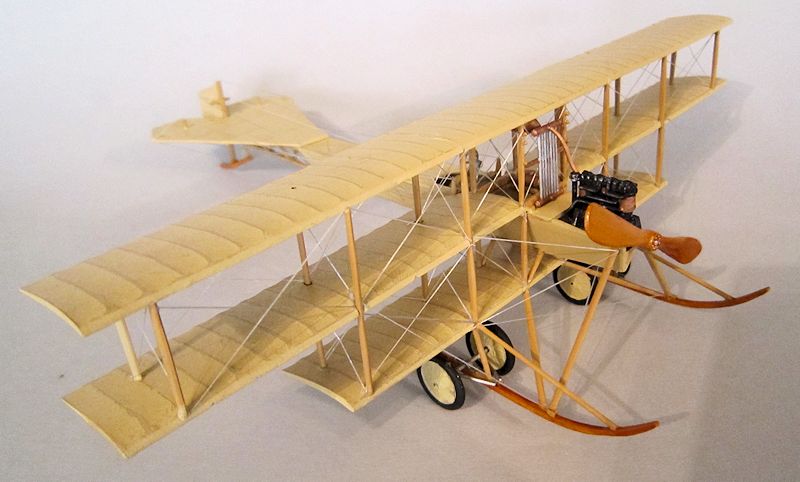
| KIT #: | P-106 |
| PRICE: | $ |
| DECALS: | None save for the stand |
| REVIEWER: | Chris Peachment |
| NOTES: | Kit molds currently owned by Lindberg |

| HISTORY |
The Roe IV Triplane (the Av- bit came later, from his initials A.V.) was a
tractor triplane with the lower wing of smaller span than the upper two and a
triangular section fuselage, which was uncovered behind the pilot's seat. The
wings were connected by four unequally spaced pairs of interplane struts on
either side, the innermost pair on each side being just outboard of the upper
longerons and the outer pair connecting only the upper pair of wings due to the
shorter span of the lower wing. Although ailerons had been designed and found
satisfactory, Roe returned to wing warping for lateral control. The
undercarriage was a pair of skids e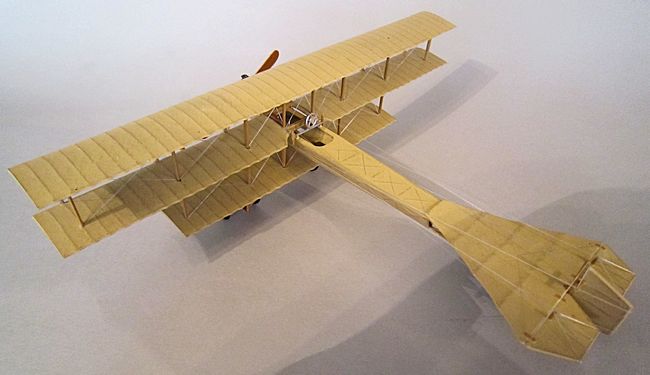 xtending forward of the propeller, with a
pair of wheels mounted on each skid, and a sprung tailskid. It was powered by a
35 horsepower Green water-cooled 4-cylinder inline engine with the radiator
mounted above the fuselage between the front struts.
xtending forward of the propeller, with a
pair of wheels mounted on each skid, and a sprung tailskid. It was powered by a
35 horsepower Green water-cooled 4-cylinder inline engine with the radiator
mounted above the fuselage between the front struts.
The single example built was used as a trainer at the Avro Flying School at
Brooklands, just outside London, where several pilots who later become famous
learnt to fly in it. During its service as a trainer it crashed numerous times,
including at least two dives into the famed Brooklands sewage farm. Since its
top speed was 25 mph, no one was seriously hurt, though no doubt they emerged
covered in glory.
And then bought
everyone in the clubhouse bar a round of drinks, which were drank upwind of the
pilot.
After one bad crash the aircraft was rebuilt with the fuselage lengthened by 4
ft and it continued to be used for pilot training until August 1911, when it was
scrapped.
A replica was made for the film of Those Magnificent Men... using drawings
provided by Geoffrey Verdon Roe, son of AV Roe. The construction of the triplane
followed AV Roe's specifications and was the only
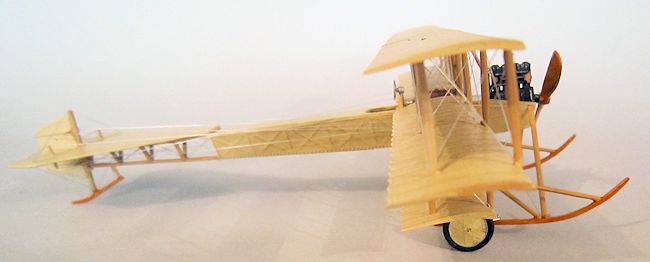 replica in the film that
utilised wing-warping successfully. With a more powerful 90hp Cirrus II
replacing the 35hp Green engine
in
the original design, the Avro Triplane proved to be a good performer even with a
stuntman hanging from the fuselage.
replica in the film that
utilised wing-warping successfully. With a more powerful 90hp Cirrus II
replacing the 35hp Green engine
in
the original design, the Avro Triplane proved to be a good performer even with a
stuntman hanging from the fuselage.
It was piloted in the film by Sir Percy Ware-Armitage played by Terry-Thomas,
clad in Edwardian sporting tweeds, of the sort which can repel scimitar thrusts,
and coated with a thick veneer of caddishness. I can't remember if he had a
deer-stalker, but no doubt there was a hair net in place to keep his moustache
seemly while airborne. And a large Havana cigar. The replica was then given to
the Shuttleworth collection at Old Warden airfield in Bedfordshire, where it
flies to this day. Usually with a Union Flag fluttering proudly from the outer
struts.
| CONSTRUCTION |
The kit is in remarkably good condition for its age and had no flash or moulding
problems. All the parts were crisply detailed and there is even a very good
textured representation of linen where applicable.
Before starting I gave the whole aircraft, including struts and propeller, a
coat of medium brown paint, for which I used Middle Stone from the Lifecolor
range. Then all linen surfaces were given a couple of coats of CDL for which I
used Vallejo buff. Once thoroughly dry the wings and tail and fuselage were
given a light sanding so that the brown showed through for the ribs and fuselage
frame. The effect is regular and quite
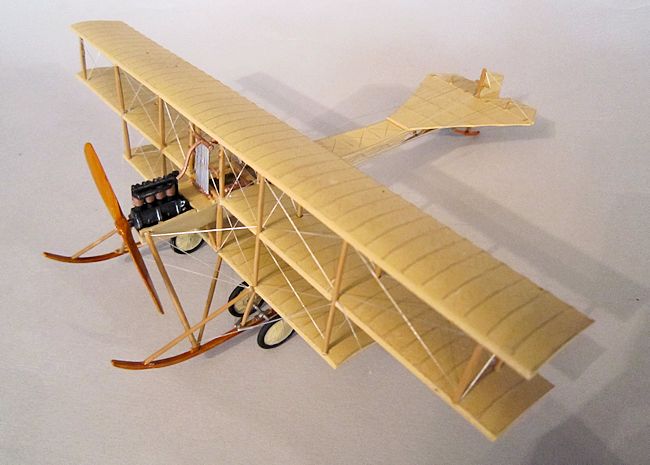 pleasing.
pleasing.
Assembly is very straightforward, with good diagrams in the instructions. There
are a few locating lugs for the struts which stand proud, though they are not
very visible. Younger modellers might find them handy and they are easily
removed if you are a seasoned old codger who objects violently to anything which
helps make life easier. “Codger”, in use since the 17th century,
apparently derives from the word cadger. But I think it is much more likely a
contraction of “coffin dodger”.
Enough etymology. There is really very little to add about construction. The
main part of the work is in preparation and painting, and after that it all
falls together like a dream.
All
the struts are the correct length and fit perfectly. And of how many modern
biplane kits can you say that? Truly, we have not advanced far in the 60 odd
years since the kit appeared. If Lindberg hold good to their promise in their
website catalogue to re-release the kit soon, a whole new generation of
modellers will be amazed at how sophisticated things used to be back at the dawn
of time, when men wore suits and ladies didn't step out the house without hat
and gloves.
Once all assembled, the rigging can begin. And I cannot say often enough, that
if you do lots of it, it will soon become a pleasure and the making of any
biplane. Without rigging, a biplane looks like a matinee idol who is toothless
and bald.
And would you like to see
that on Brad Pitt, ladies?
The engine is matt black with some dry brushing of gunmetal to lift the detail.
The water jackets around the cylinders are old copper, as are the water pipes
and header pipes for the radiator. The radiator tubes are gunmetal.
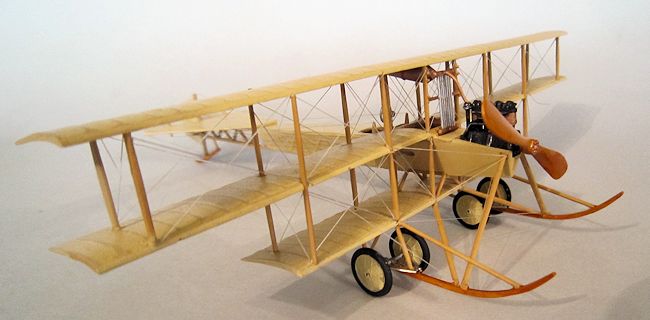 The wheels are Inpact's only disgrace and have clear discs in the middle with
spoked engraved. I ground off as much of the spokes as I could with an old
scalpel blade,
gave them a coat of
linen, and allowed that at least some of the spokes would still show through
their covers.
Several kind readers
of my last review of an Inpact Martin-Handasyde sent me details of where to find
hand made spoked wheels, but I am afraid that I couldn't justify the cost, which
is huge. I didn't glue the wheels on, and await the day when some etched
alternatives become available. Though even those have a nasty tendency to
contract wavy rims when you try to dish them.
The wheels are Inpact's only disgrace and have clear discs in the middle with
spoked engraved. I ground off as much of the spokes as I could with an old
scalpel blade,
gave them a coat of
linen, and allowed that at least some of the spokes would still show through
their covers.
Several kind readers
of my last review of an Inpact Martin-Handasyde sent me details of where to find
hand made spoked wheels, but I am afraid that I couldn't justify the cost, which
is huge. I didn't glue the wheels on, and await the day when some etched
alternatives become available. Though even those have a nasty tendency to
contract wavy rims when you try to dish them.
Finally, as always, the propeller was given a coat of clear orange (I had left all the struts bar the skids in natural wood colour) and was fixed at the ten to four position, which nearly all of my propeller aircraft sport. No doubt a shrink reading this is going to advise me shortly that I have an Obsessive Compulsive Disorder which only a long and expensive course of therapy will cure. Let me say now that I don't, and even if I do, then I don't want it cured. I like my propellers at ten to four. And sometimes five to five for a little elegant variation.
| CONCLUSIONS |
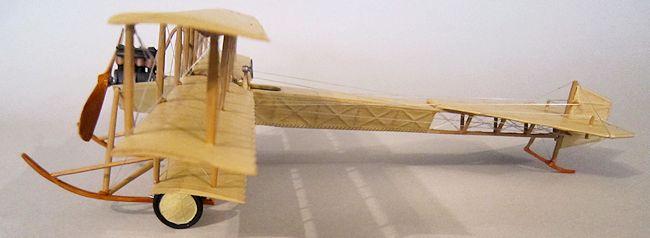 I like this largeish kit very
much indeed. Aircraft from before WWI are largely ignored by manufacturers,
in the belief that they are too difficult for most modellers. Nothing
could be further from the truth. Like the aircraft themselves, they are easily
put together by only semi-skilled labour, using techniques which date back to
the dawn of tool invention. They lend themselves easily to scratch-building,
because they lack compound curves. And they are so very pleasing.
I like this largeish kit very
much indeed. Aircraft from before WWI are largely ignored by manufacturers,
in the belief that they are too difficult for most modellers. Nothing
could be further from the truth. Like the aircraft themselves, they are easily
put together by only semi-skilled labour, using techniques which date back to
the dawn of tool invention. They lend themselves easily to scratch-building,
because they lack compound curves. And they are so very pleasing.
| REFERENCES |
http://www.theaerodrome.com/forum/pioneer-aviation/41212-your-favorite-pre-war-aircraft.html
http://www.airliners.net/photo/Avro-Triplane-(replica)/1486685/M/
http://airmuseumsuk.org/airshow/2004/Shut040606/index.htm
http://www.werkost.com/Avro.htm
http://www.airmuseumsuk.org/airshow/2004/Shut040502/800/index_2.htm
April 2014
If you would like your product reviewed fairly and fairly quickly, please contact the editor or see other details in the Note to Contributors.